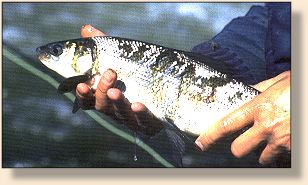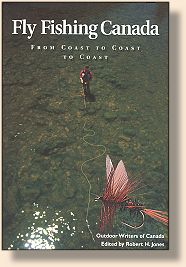Lake Whitefish On Dry Flies

By Gord Ellis
From Fly Fishing Canada, Published by Johnson Borman Publishers
Lake Whitefish are Canada's most overlooked game fish, and
for no apparent reason. They take a dry fly with vigor
and fight with spirits - if somewhat spastic - determination.
Whitefish are also a great on the table, and in most
jurisdictions their sheer numbers allow for a guilt-free
harvest. Canadian fisheries managers have been trying
for years to promote whitefish as an under-utilized
species - sort of a poor man's salmon. Luckily, when
taken on a fly, a whitefish will blow away a similar-sized
brookie, laker or brown trout, so given the chance, a whitefish
sells itself.
Whitefish aren't suckers. They're also not bony, nor oily.
In fact they are few of the things that most people think
they are. Whitefish are, in fact, more closely related to
trout than to suckers and sport a very troutlike adipose
fin. They do have large scales and a small, pouty mouth,
but run a fillet knife through that body and you'll find
the bone structure of a salmonid and fine, flavorful meat.
If you've wanted to catch a few whitefish but have had some
difficulty in the past, there is no better time to try than
during the may fly hatch. Timing the hatch in Canada varies
depending on our latitude, but most hatches occur from late
May to mid-July. Track down an entomologist or biologist
in the area where you live, and they will be able to tell
you when the peak of the may fly hatch occurs. The key to
making good whitefish catches during the may fly hatch is
to fish on the surface, and no technique is more successful
than classic dry-fly fishing.
My first real introduction to dry-fly fishing for whitefish
took place at Ivanhoe Provincial Park near Chapleau, Ontario,
on Canada Day (July 1), 1990. The height of the may fly hatch
usually falls on the first week of July in northern Ontario,
which is why the local Ministry of Natural Resources was holding
a Whitefish Weekend at the park. The may flies were going and
the bite was on. Local angler John Seyler and I spent a couple
of very enjoyable hours fly fishing the reedy shoreline of a point
no more than a stone's throw from the Junior Ranger Camp on
Ivanhoe Lake.
The bottom was dark, muddy and shallow - perfect conditions
for a mega-sized may fly hatch. We started fishing the lake
two hours before the main body of the hatch, yet the whitefish
were already lying in wait for that magic moment. Anchored in
the canoe, enjoying the muggy afternoon air, we methodically
cast to the reed edges and let our flies float on the calm
surface. Strikes came quickly, usually in less than a minute
if our may fly imitating presentation was sitting high and dry
on the water. The whitefish would erupt suddenly under the fly,
causing it to disappear into a plate-sized swirl. My heart
skipped several beats thanks to these surprise attacks.
At nightfall when the may fly hatch kicked into gear, the
whitefish went crazy. In an effort to slurp up as many of
the insects as possible, the fish became less wary of a
water-saturated fly. Strikes came steadily and double
headers were common. By the time it became too dark to
thread a line through a hook eye, the fish were on a rampage,
striking with abandon. Even a cigar butt was fair game.
Seyler called it "a feeding frenzy in every sense of the word"
as hundreds of whitefish turned the surface of the lake into
a seething cauldron, their silver flanks flashing in the
moonlight. We had a blast that night, catching and landing
over a dozen 2 - 3 lb (900 g-1.4-kg) fish, while losing
countless others due to those paper-thin mouths, slippery
scales and our lack of a landing net.
As the moon appeared, the hatch slowed and we went back to
camp, wet, slimy and smiling. By any measure it was great
fishing, yet only one other angler had been there enjoying
the phenomenal action. Since that day I have experienced
similar dry-fly fishing for whitefish in several Canadian
provinces, and I continue to be struck by the lack of anglers
taking it in. That's a shame.
Medium-weight fly gear is all you need for whitefish angling.
A 6-weight fly rod, single-action reel and weight-forward
floating line will do the trick nicely. For lake fishing
during the hatch, I like an 8-9' tapered leader with a
4-6-lb test clear tippet. This setup will do justice to
just about any whitefish you run into, and since they can
grow to double-digit proportions, a 6-weight will allow you
to land any larger fish that may come along. You'll be amazed
at how hard these fish pull.
A varied selection of may fly- and caddis-imitating dry flies,
a hook hone and a bottle of fly floatant will round out the
required equipment.
Long, graceful casts are not usually important in this game,
so don't be afraid if you're inexperienced. When whitefish
are biting, a short roll cast from the boat or shore is usually
fine. Douse your fly liberally with floatant, or it will
drown under the barrage of whitey strikes and be virtually
useless. The use of floatant helps keep flies on the surface
longer, but it's a good idea to carry lots of flies so you don't
run out of bone-dry ones to throw. Wear a bandanna or hat and
dry your soaked flies on it. Whitefish are not super
discriminating about dry flies, but my favorite patterns
lean toward old classics that include both the Gray and
White Wulff, March Brown, and Mosquitoes in sizes ranging
from No. 12-8.
Although lighter-colored flies are a little easier to see,
I've found that neutral or grey-colored imitations are most
attractive to surface-feeding whitefish. Occasionally, the
addition of two or even three flies to a leader can create
a feeding frenzy without the benefit of real may flies.
This works especially well in the early part of the evening
when the whitefish are "looking." Attack the flies to the
leader by leaving a long tag end off the top hook eye, or
just add an 8" length of leader on the hook shank of the
preceding fly. Using the same size and color of fly is a
good bet if you want to mimic a may fly hatch, but occasionally,
adding two or three different sizes and colors of flies will
allow you to figure out quickly which pattern the whitefish
want. (Editor's note: Always check provincial/territorial
fishing regulations to ensure whether or not more than one
fly can be use, and if so, the maximum number permissible.)
When searching out feeding whitefish, watch for boils on
the surface and the occasional forked tail slicing the water
as signs that the silver fish are gearing up for dinner.
Muddy-bottomed bays, weed beds, reed-tipped points, swimming
beaches and tapering shorelines are all high-probability spots
for major may fly hatches. The fish will be cruising around
the reed beds and along the edges of submerged weed beds,
waiting to pounce on the flies as they emerge. The splashy
take of a whitefish is an exciting thing to witness, especially
when it's your fly that is being whacked.
 Expect to miss a lot of strikes and lose a lot of fish when
fly fishing for whitefish. They have a small mouth, and the
membrane that connects the jaws is paper thin. If a fish
strikes your fly, wait to feel it on the line before gently
lifting the rod tip to set the hook. A sharp hook really
increases hooking success. Play the fish gingerly and take
a net - trying to hand land a whitefish is a nerve-wracking
experience as they inevitably get off due to those extremely
slippery scale.
Expect to miss a lot of strikes and lose a lot of fish when
fly fishing for whitefish. They have a small mouth, and the
membrane that connects the jaws is paper thin. If a fish
strikes your fly, wait to feel it on the line before gently
lifting the rod tip to set the hook. A sharp hook really
increases hooking success. Play the fish gingerly and take
a net - trying to hand land a whitefish is a nerve-wracking
experience as they inevitably get off due to those extremely
slippery scale.
Fly fishing for whitefish during the may fly hatch is a hoot!
It requires only a modicum of skill and equipment while
providing maximum fun. In fact, whitefish angling during
the may fly hatch deserves to become a Canadian fly-fishing
tradition. ~ Gord Ellis
|



